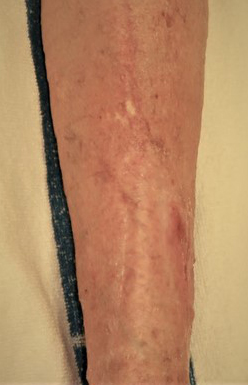History of an
ulcer that does not heal
You’ve had a leg ulcer for a long time. You’ve undergone various topical treatments and you’ve used a multitude of different dressings, but the ulcer does not heal and you also have a lot of pain. This process generates fatigue and frustration for you as a patient, and also for the health personnel who are treating you.
Did you know that there is a technique that can help you, very simple to perform and effective at the same time?

I am dr.
Verónica Ruiz
I began my specific training in wound care during my training stay in the Burn Unit of the Vall d’hebron Hospital.
I continued my learning during my training stay in the Wound Unit of the Vicente Soldevila Health Center (Infanta Leonor Hospital) led by Dr. Elena Conde.
Thanks to Dr. Conde and her team, excellent professionals and persons, I was able to learn this technique and other important concepts related to wound care that I have been able to apply in my daily clinical practice.
Pinch grafting as a solution to a chronic ulcer that does not heal
With this technique you will see how:
- the ulcer gradually closes over the course of several weeks,
- the associated pain is significantly reduced in a few days.
- The evident improvement that you will observe will undoubtedly be reflected in a significant improvement in your quality of life.
This technique was firstly described in 1869 to treat chronic ulcers due to chronic venous insufficiency in inferior extremities and consists of the transplantation of small pieces of shaved superficial akin from an area of healthy skin or another area of damaged skin, by means of the use of scalpel blade and surgical forceps.
Example 1:
Chronic ulcer left leg


Example 2:
Chronic ulcer right leg


Pinch grafting: a simple technique that allows you to treat complex wounds
It is a simple, efficient and low cost technique
which is performed on an outpatient basis under local anesthesia.
Substantially reduces local pain
Not only does it represent an excellent alternative to cure some chronic ulcers, but one of its main advantages is the significant decrease in local pain associated with the ulcer itself, which in most cases happens already in the first days after performing the technique.
Which patients are candidates for the use of this technique?
Pinch grafting is used for the treatment of chronic ulcers, usually in legs, of different causes, however the most extensive experience in the literature refers to the treatment of ulcers in the context of chronic venous insufficiency, arteriolosclerosis (Martorell`s ulcer) and diabetic ulcers.
Initially, any patient with chronic ulcers and with an adequate blood supply to the tissues may be a tribute to the realization of this technique, although those patients with partial arterial obstruction, which would cause a blood risk difficulty, could not be considered good candidates for this technique.
Frequently asked
questions
The clinical reviews after the technique are usually carried out twice a week, so that the progress of the epithelialization, the need for changes in the dressings and if the injury requires the realization of a second round of treatment can be assessed.
It is recommended, if possible, both the day of the performance of the technique and the subsequent cures, the patient should be accompanied.
Generally, the patient is instructed to perform a more strict immobilization during the first 3 days after the technique (to remain seated with the legs elevated most of the time, alternating with short walks at home), increasing in a way slow and progressive periods of wandering from the 4th day.
The patient usually feels fine and what is most gratifying for the patient is the important reduction in pain that previously the experienced because of the ulcer, experiencing a good relief already past the 2 first days after the treatment.
We have to take into consideration, that in some occasions and due to some circumstances related to the etiology of the ulcer and the medical context or history of every patient, it might be necessary to repeat the process various times during a period of time until a complete closure of the ulcer is achieved.
It is not necessary to carry out any specific prior preparation by the patient,
The only thing that must be taken into account is the fact of resting during at least the first post-technical week.
